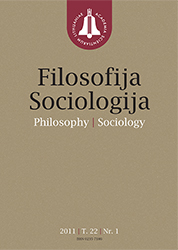Filosofija. Sociologija / Philosophy. Sociology
WHAT?
 ISSN 0235-7186 ISSN 2424-4546 (online) |
2017 m. Nr. 4 Evaluation of the Relationship between Labour Taxation and Unemployment: Case Study of Lithuania in the EU Context
This paper analyses the impact of labour taxation on the labour market (its indicators), measures the relationship between labour taxes and the rate of unemployment in Lithuania, and seeks to establish whether the tax wedge has an impact on employment. The obtained results suggest that the unemployment rate in Lithuania tends to vary mainly due to cyclical economic fluctuations. However, to some extent, the level of unemployment, especially of unskilled labour, depends on its taxation. In Lithuania, the tax wedge on low-wage earners, i.e. those paid a little more than the minimum wage, is relatively high in the context of other EU countries. However, the overall labour taxation (describing all labour force) is low because of a relatively low taxation of high-income individuals. The article examined the scientific literature which confirms the existence of a link between the taxation of low-skilled and low-paid workers and the unemployment rate for this group. In addition, labour taxation and benefit levels can influence people’s motivation to take up a job. The conducted estimates support a direct link between the economically inactive population (aged 20–64) and the unemployment trap indicator. A greater unemployment trap leads to a bigger percentage of the economically inactive population in the country.
Keywords: labour taxation, tax wedge, tax burden, unemployment trap, economic cycles |
Numeriai:
2017 - T.28 Nr.1, Nr.2, Nr.3, Nr.4 2016 - T.27 Nr.1, Nr.2, Nr.3, Nr.4 2015 - T.26 Nr.1, Nr.2, Nr.3, Nr.4 2014 - T.25 Nr.1, Nr.2, Nr.3, Nr.4 2013 - T.24 Nr.1, Nr.2, Nr.3, Nr.4 2012 - T.23 Nr.1, Nr.2, Nr.3, Nr.4 2011 - T.22 Nr.1, Nr.2, Nr.3, Nr.4 2010 - T.21 Nr.1, Nr.2, Nr.3, Nr.4 2009 - T.20 Nr.1, Nr.2, Nr.3, Nr.4 2008 - T.19 Nr.1, Nr.2, Nr.3, Nr.4 2007 - T.18 Nr.1, Nr.2, Nr.3, Nr.4 2006 Nr.1, Nr.2, Nr.3, Nr.4 2005 Nr.1, Nr.2, Nr.3, Nr.4 2004 Nr.1, Nr.2, Nr.3, Nr.4 2003 Nr.1, Nr.2, Nr.3, Nr.4 2002 Nr.1, Nr.2, Nr.3, Nr.4 2001 Nr.1, Nr.2, Nr.3, Nr.4 |